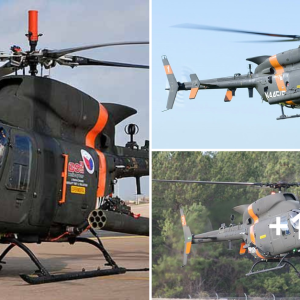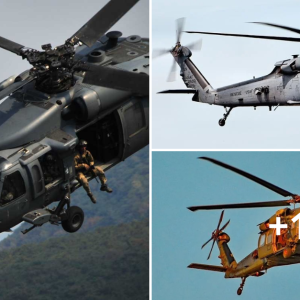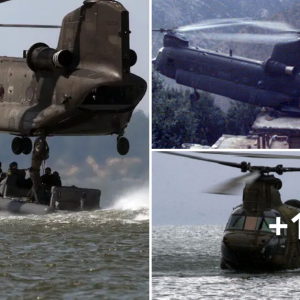‘There it is! Mach 2.0, twice the speed of sound. I could go on, Mach 2.4 is probably within reach,’ Ed Cobleigh, former F-4 Pilot.

The McDonnell two-place, twinjet, all-weather F-4 Phantom II, with top speeds more than twice that of sound, was one of the most versatile fighters ever built. It served in the first line of more Western air forces than any other jet. Just 31 months after its first flight, the F-4 was the US Navy’s fastest, highest flying and longest-range fighter. It first flew May 27, 1958, and entered service in 1961.
The F-4 established 16 speed, altitude and time-to-climb records. In 1959, its prototype set the world altitude record at 98,556 feet (30,000 meters). In 1961, an F-4 set the world speed record at 1,604 mph (2,581 kph) on a 15-mile circuit.
The US Air Force’s first version, the F-4C, made its first flight in May 1963, and production deliveries began six months later. Phantom II production ended in 1979 after over 5,000 had been built — more than 2,600 for the USAF, about 1,200 for the US Navy and Marine Corps, and the rest for friendly foreign nations.

The following story appears in Ed Cobleigh’s book War for the Hell of It: A Fighter Pilot’s View of Vietnam. Bestselling author Ed Cobleigh has been a fighter pilot with the US Air Force, US Navy, Royal Air Force, Imperial Iranian Air Force, and the French Air Force. He also served as an Air Intelligence Officer working with the CIA, FBI, and M16 on a variety of covert projects. He knows fighter planes, fighter pilots, and air combat well. His first fighter plane was the F-104 Starfighter and the last was the F-16 Viper. He flew 375 combat missions with the same number of landings as take-offs.
F-4 Test Hop
‘To record the flight time, I punch the stopwatch stem on the instrument panel; it’s time to clock in at the job site. Release the brakes, shove the big throttles forward into afterburner, hold down the nose wheel steering button, pull the stick full back, and we’re rolling. The Phantom, which was straining nose down under full military power against the brakes, leaps forward, eager to be shed of the ground.

‘The twin afterburners torch off with a thump and a kick in the ass, thrust is reporting for duty, a quick check of the exhaust nozzle gages, both full open, no warning lights. Speed is building quickly now as the two J-79 engines howl, blue afterburner plumes blasting the runway behind, pushing the F-4, lightweight for once, into the sky. One hundred knots, release the nose wheel steering, the rudder is effective now keeping us straight down the rapidly disappearing concrete. The runway is passing under the jet much faster now, the flat scenery alongside the strip is a green blur.
‘At 150 knots, the nose starts to rise, lift is overcoming gravity, stop it at ten degrees above the horizon until we lift off, which follows immediately, vibration from the wheels ceases. Slap the long landing gear handle up, retract the flaps with the small yellow lever on the left cockpit wall. The nose wants to keep climbing, stop it with forward stick and run the pitch trim nose down. Hold the big jet down over the runway, one hundred feet sounds about right, as the speed continues to build relentlessly.
‘The departure end runway flashes under the nose, followed in an instant by the airfield boundary, then the perimeter fence. Still more nose down trim needed to comfortably hold the nose steady, it wants to pitch up. 400 knots, 425, 450, time to go upstairs.

‘I let the stubborn nose climb past the dusty horizon and keep it coming up, up, up, I’m more letting it do what it wants than using back stick. Forty-Five degrees of pitch, sixty, then ninety, we’re going straight up, Jack’s and my weight is transferred from our asses on the ejection seat cushions to our spines on the metal seat backs. The Phantom climbs like a homesick angel, a brown and green angel that is, with fire spurting out of his/her ass.
‘Jack and I are off on a test hop, a Functional Check Flight, a FCF. FCFs are required whenever any heavy maintenance is done on the aircraft such as an engine change. FCFs are flown with a totally clean aircraft, no drop tanks, no missiles, no ECM pods, no wing pylons; the underside of the jet is as smooth as baby’s butt. We are limited to one combat mission a day, but we can fly FCFs over Thailand without restrictions. As the squadron FCF pilot, I fly these joy rides whenever I can.
‘I stood the Phantom on its tail and departed the airfield straight up. Why? Why does a dog lick his balls? Because he can. All FCF pilots perform the same spectacular departure because it’s fun, but also to show off the Phantom’s performance to the ground crewmen; it’s an time-honored tradition. The crew chiefs, maintenance troops, aircraft mechanics, aka the Phantom Phixers, work long hours in the blistering Thai sun, in the monsoon rains, day and night. They see their jets depart loaded with ordnance and headed northeast. An hour or two or three later the same aircraft return, the ordnance gone and often something on the planes is broken, or shot up, which has to be fixed, by them. They seldom get to experience just what their precious charges can do, to see the Phantom really perform. Hence the vertical climb out.

‘Out of sight of the field, I lower the nose to a more sustainable climb angle, afterburners still at full blast, and continue climbing, turning westward, then south to stay in Thai airspace. jack hasn’t said much, as usual. He likes to fly these FCFs although there isn’t much for a navigator to do, because he, like I do, enjoys having a jet to screw around with.
‘20,000 feet comes quickly, then 30,000. The air gets much thinner the higher we go and the rate of climb slackens; less lift, less thrust. I have to lower the nose to maintain airspeed. 40,000 feet, maximum altitude for most commercial aircraft. 45,000, tops for the propeller-driven fighters of WWII and the SabreJets of the Korean W4r. 50,000 feet and I level out to gain some more speed. It’s the maximum altitude we are allowed to fly without wearing full pressure suits like the one Neil Armstrong wore on the Moon, only without the gray, grimy moon dust.

‘Einstein said all speed is relative. He was right. With no clouds to fly past, no visual contact with any recognizable surface features, no other aircraft, we are up here all alone and there is no sensation of speed. The cockpit noise is constant, the engines continue to howl, the throttles haven’t moved from full afterburner since brake release three minutes ago. We seem suspended motionless in the space/time continuum. Only the increasing Mach meter read-out gives any indication of speed. It reads .9, nine-tenths the speed of sound and accelerating. As I watch, the Mach number climbs, .93, .95, .97, it hangs up for an instant and then jumps to 1.02. We are supersonic and still accelerating, the maniacal engines will not be denied. With nothing else to do, I watch the Mach meter unwind; I want to see a number starting with a 2.
‘On the far side of the so-called sound barrier, the airflow around the Phantom has now changed radically. Shock waves are now attached to the nose and tail. In a few seconds, Thai farmers slip/sliding along behind stoic water buffalos plodding through their flooded rice paddies will be treated to a sharp boom marking our swift passage through the sky far above them. Supersonic, the flight controls are less effective, they seem stiff and unresponsive, particularly in pitch, the downward-slanting stabilators on the tail have less control authority.

‘There it is! Mach 2.0, twice the speed of sound. I could go on, Mach 2.4 is probably within reach. Instead, I ease the stiff stick back and the jet climbs again, trading airspeed for altitude, exchanging kinetic energy for potential energy, leaving the relative safety of 50,000 feet for the unexplored, ever-thinner air above us. 55,000 feet, 60,000. We aren’t suppose to be up this high, but what the hell, I fly combat missions most days despite the Flight Surgeon’s wise advice that bullets are not to enter my body at any time.
‘What did they teach us in aviation physiology? At 63,000 feet, coming up now on the altimeter, the boiling point of water is 98 degrees. If we lose cabin pressurization, not an unlikely event at this height, our blood will boil and our gooses will be cooked, literally. Yikes!

‘I roll the F-4 up on its left side mid let the nose fall through the seemingly rounded horizon, starting back down. I dare not touch the throttles, the engines have little stall margin in the diasporas air up here and if we flame out the engines, we lose cabin pressure. The altimeter unwinds back to 50,000 feet and we can breathe easier again. I start a turn back to the northwest, our fuel is getting low. Still supersonic, I pull the throttles back out of afterburner to a more moderate power setting. With the stick full back, I can only get three Gs as I point the nose toward Ubon…. and oblivion, Everything goes black.
‘Is this what being dead is like? I am conscious but totally alone in an empty black void with no sensory inputs. No sight, no hearing, no feeling, just me and vacant blackness all around. Descartes said, “I think, therefore I am.” What if I can think but I am not? Slowly, slowly, I come to a heightened state of consciousness and I realize where I am and what has transpired. I can hear air rushing over the canopy somewhere out there in the void. Now, my vision is returning, but I am looking through a soda straw at my lap, my chin is resting on my chest. More sight comes and I can see my leather-gloved hands in that distant lap, not on the control stick. I know they are my hands by my big fighter pilot wrist watch, but I can’t move them, they’re still paralyzed and I can’t raise my head to look around.

‘I know now what happened. When the jet came back through the Mach to the sub-sonic flight regime, the stabilators regained their purchase on the airflow, dug in, and my three G pull instantly became a seven G turn. The instant onset of seven G’s, causing my body to weigh over 1200 pounds, blacked me out without warning as the blood drained from my brain, pulled downward by seven Gs. I’ve experienced this a few times before and it always seems an eternity until I can see and move again. While I’m waiting, all I can think is, “How long have I been out and what has the airplane been doing while I was gone?”
‘Finally, I can move again, I raise my head, grab the stick, and look outside. Above me, out the top of the canopy, is the ground, still far below. We are inverted, but still at altitude, I must not have been out long. Rolling the jet right side up, I take a deep breath of metallic-tasting oxygen from my soft rubber mask, get my bearings, pull the power back and start a long glide to base.

‘I ask Jack, “Are you OK?”
‘”I’m back,” is all he says.’
Photo credit: U.S. Air Force





